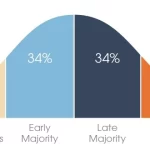The #1 Cause for New Product Failure and How to Fix It
Most people think that innovation is “inherently risky and messy.”
That’s understandable when you consider that 50-90% of all new products fail; it seems pretty obvious. And yet, surprisingly, it’s not true. There’s a way to dramatically reduce risk, increase success rates, and turn innovation and growth into a repeatable business process. But first, we have to understand the two key risks of innovation and how to mitigate them.
The Two Key Risks of Innovation
Product/service innovation is not an event with one risk factor measured by new product success rates. There are many steps in a successful innovation process each with their own risks. At high level, however, there are just two risks:
- Market risk, i.e., the risk that customers won’t buy what we make because we misunderstood what they want.
- Solution risk, i.e., the risk that we cannot make what customers want.
Research has repeatedly shown that the number one cause of new product failure is misunderstanding the customers’ needs, i.e., market risk. In fact, the authors of the popular book, Nail It Then Scale It, Furr and Ahlstrom, state that 95% of new business failures are due to misunderstanding the customers’ needs (market risk).
Therefore, if you can minimize the market risk by gaining a thorough understanding of the target customers’ unmet needs – and you can – then you can dramatically improve your commercial results. That’s exactly what the Jobs-to-Be-Done (JTBD) enables firms to do.
How to Create a Better Pen
If I were to ask you to “come up with a better standard pen,” what would you suggest?
Probably nothing because it’s hard, right? But note, it’s not hard because “innovation is inherently risky and messy.” It’s hard because we have not executed the first step in any successful innovation process which is to discover the target customers’ unmet needs. We don’t yet know what constitutes a “better pen.” I have not provided you with any concrete actionable customer need statements.
The key to success is to shift your focus away from generating ideas to helping your target customers get their jobs done better. That’s because people “hire” products and services to get their jobs done. So, for example:
- People hire drills to make holes
- Doctors hire stethoscopes to listen to their patients’ heart and lungs
- And your customers are hiring your product/service to get specific jobs done, too
That means that, if you can help your target customers get their jobs done better than other competitive options, and you almost always can, then you can create unique value and drive growth in a predictable manner.
If a trained JTBD practitioner were to interview some pen users for you and asked customers, “What are you trying to accomplish with your pen?” or “Why is having a pen important to you?” we would learn very quickly that the core job to be done is to “Record information for future reference, e.g., lecture points in a class, items to purchase at the store, etc.”
We know that, for every functional job people want to get done, they have known criteria for measuring the successful execution of each step in the process. It takes a skilled interviewer to draw these criteria out, but that is very different than saying “customers have needs that they cannot articulate.”
Two questions that are particularly effective at revealing customer criteria for success are, “What makes using your pen challenging, difficult, or frustrating?” This would reveal that people want to:
- Minimize the likelihood of getting hand cramps/fatigue when writing for an extended period of time
- Minimize the likelihood of running out of ink unexpectedly
- Minimize the likelihood of ink smudges, e.g., on hands, clothes, paper, etc.
- Etc.
On a typical JTBD study, we would discover 50 – 150 need statements like these, or about 6-8 criteria for each of multiple steps in the process of getting the job done. Now, suppose you knew that customers considered these three criteria above to be both important and unsatisfied by current pens, do you think you could come up with some ways to “make a better pen?” Absolutely! That’s because a well-defined customer need is half-satisfied. The best creativity trigger is a well-defined customer need.
Any Firm Can Be Successful at Innovation IF…
Any firm can be successful at innovation if you know what type of customer information to obtain, how to get it, and how to use it. Then you can dramatically reduce your innovation market risk, change the game, and achieve success rates 2-5 times higher than average. Knowing where to focus and what to do makes all the difference in the world.
Learn more about how you can turn innovation and growth into a repeatable business process at https://revealgrowth.com/jobs-to-be-done/.




